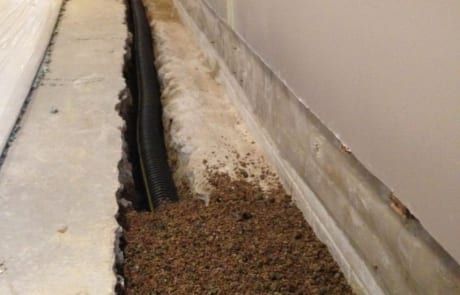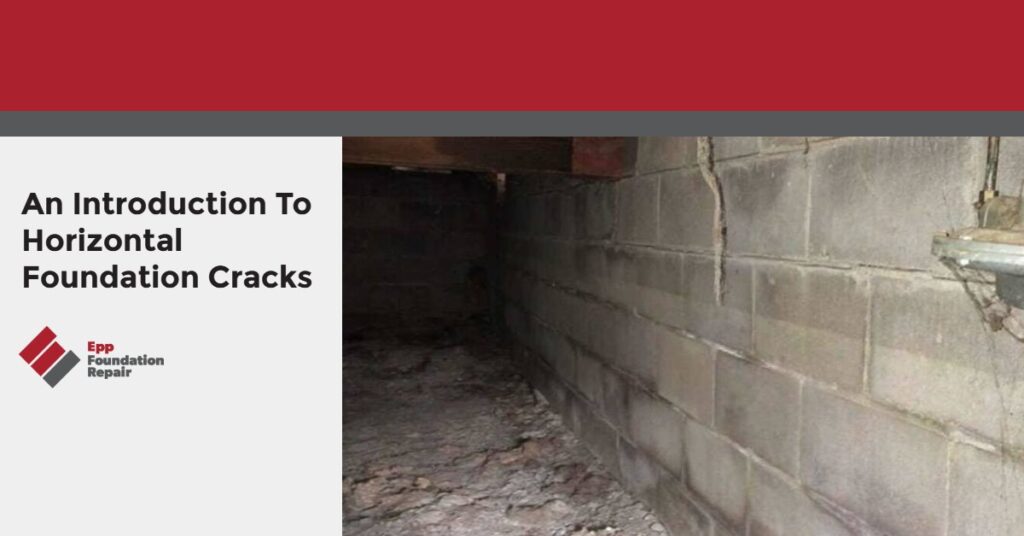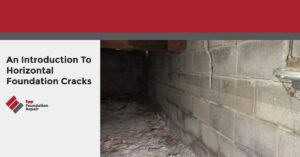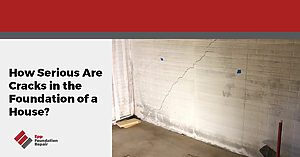Horizontal foundation cracks can be pretty alarming, especially if they’re large. Unfortunately, they’re usually a sign of foundation trouble. Horizontal foundation cracks need to be inspected by a foundation repair contractor right away. If you wait, the crack will get worse, and you’ll be facing a more expensive repair. You also want to make sure your home is safe.
In this article, we’re going to talk about what you need to know about horizontal foundation cracks, the causes of horizontal foundation cracks, repair options, prevention, and more.
Horizontal foundation cracks are structural and therefore more serious
Foundation cracks fall into two general types: structural and non-structural. Structural foundation cracks can affect the structural integrity of your foundation, while non-structural cracks are mainly just ugly. Unfortunately, horizontal foundation cracks fall into the first category. They are usually structural.
Compare: Vertical cracks are usually non-structural
Hairline vertical cracks are usually caused by shrinkage during the concrete curing process. While they’re unsightly and can allow water to seep into your basement, they don’t affect your home’s structural integrity. Horizontal foundation cracks, because they’re structural, are more serious than vertical foundation cracks.
For more information about structural vs. non-structural cracks, see Structural or Non-Structural? Understanding Foundation Cracks.
What causes horizontal foundation cracks?
Horizontal foundation cracks in a basement wall are usually caused by,
- Hydrostatic pressure – When excess water builds up in the soil around your foundation that can’t drain off, hydrostatic pressure builds up and starts pushing against the basement wall. If the pressure isn’t relieved, the wall could bow inward and even crack. Horizontal cracks in a basement wall are often caused by hydrostatic pressure, and these cracks tend to form halfway between the top of the dirt on the outside of a wall and the bottom of the wall.
- Expansive soil – Soil with a lot of clay in it expands when it absorbs water and shrinks when it dries out. If the soil around your home is expansive and saturated with water, it will exert pressure on the foundation walls, which could eventually cause bowing and horizontal foundation cracks.
- Freeze/thaw cycle – If you live in a cold region and the horizontal foundation crack falls within the frost line, it was probably caused by the freeze-thaw cycle. Soil expands when it freezes and pushes against the foundation wall. Over time this could lead to cracks.
- Something heavy parked next to the foundation – Horizontal cracks higher up on the wall might have been caused by something heavy like a big truck parked next to the home.
As noted above, horizontal cracks are more serious than vertical cracks and can affect your home’s structural integrity. Both concrete block and poured concrete foundations can have horizontal cracks.
When to worry about a horizontal foundation crack
Horizontal foundation cracks are always a cause for concern. If you see any, contact an experienced foundation repair contractor right away for an inspection. If you wait, the crack will get worse, and you could be looking at an even bigger repair bill. Most repair contractors will do an inspection for free and then offer a repair estimate.
How horizontal foundation cracks are repaired
If a horizontal foundation crack was caused by lateral pressure on the wall, three possible repair options are wall plate anchors, carbon fiber straps, and I-beams. These methods will stop the wall from bowing further and close the crack. In case of severe bowing, the wall would need to be rebuilt, and this is a job for a mason.
Wall plate anchors
Wall plate anchors correct bowing walls by attaching a plate to the inside of the basement wall and then connecting it via a high-strength rod to an anchor placed in the dirt outside the wall. This pulls the wall outward and corrects the bowing.
Carbon fiber straps
I-beams
Structural bracing counteracts the stress being put on the wall and prevents further inward movement. It’s a good option for when wall plates can’t be used and doesn’t require excavation.
How to prevent horizontal foundation cracks
Since most foundation problems, including horizontal foundation cracks, are caused by water – either too much or too little of it – in the ground around the foundation, you can prevent trouble by making sure you have groundwater under control. Here are some things you can do:
- Regrade your yard, if necessary – The yard around your home should slope away from the foundation, not toward it. If the yard slopes toward your home, water will drain toward the foundation. You don’t want this to happen.
- Keep water-hungry vegetation away from the foundation – If the plants and shrubs around your foundation need to be watered frequently, this will dump more water into the soil around the foundation.
- Clean your gutters regularly – Clogged gutters can cause water to spill over the side of your home and into the soil next to the foundation.
- Install downspout extensions, if necessary – If your downspouts are too short, they’ll release water next to the foundation. Downspout extensions channel the water away from the foundation before releasing it.
- Install a drain tile system – The best way – by far – to prevent excess water from building up in the soil around your home’s foundation is a drain tile system. There are two types, interior, and exterior. An exterior drain tile system is installed around the outside perimeter of the foundation at the footing level. An interior drain tile system is installed under the basement floor. They both work by channeling any excess water in the soil to a sump pit, where it’s then released away from the foundation either by gravity or via a sump pump. For more information on drain tile systems, see How Does A Drain Tile System Work?

Unfortunately, horizontal foundation cracks usually indicate a serious problem with the foundation. The good news is that most foundation problems can be fixed. So, if you have a horizontal foundation crack, contact a foundation repair contractor right away for an inspection.
If you’re in our service area in Nebraska, Iowa, Kansas, or Missouri, contact us today for a free repair estimate.







